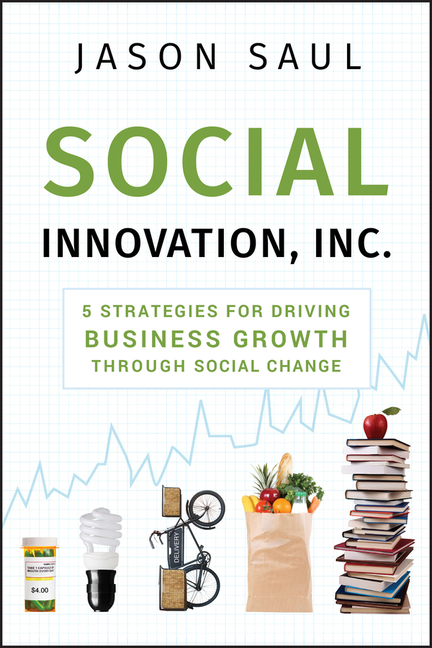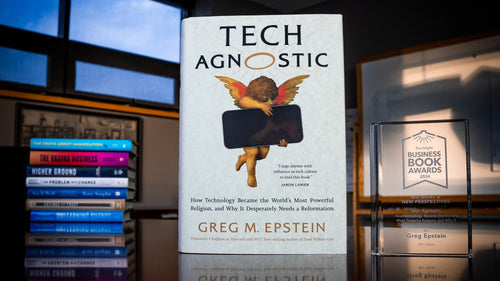An Excerpt from Social Innovation, Inc.
Recognizing the influence that global corporations have on almost every aspect of our lives today, Jason asked himself some very tricky questions, like:
Could Walmart possibly offer a better solution to health care than Medicaid? And if so...Basically, can business more greatly influence social change than philanthropy and the governments of the world? I think that we're so used to seeing corporations portrayed as villains that it's hard to accept the evidence at first blush, but evidence is there.
- Could IBM educate students better than charter schools?
- Could GE help reduce global warming faster than the Kyoto protocal?
- Could Starbucks do more to stabilize the economy in Rwanda than U.S. foreign aid?
Saul isn't the first to present this argument, but he does so less emotionally and idealistically than previous efforts—like Stoneyfield Farms' wonderful but sentimental Gary Hirshberg in Stirring It Up: How to Make Money and Save the World. I have to admit to being somewhat of a sentimentalist myself, so lines like "This book is about corporate strategy, not corporate responsibility" sound cold to me, but the book is well written and persuasive, and it advocates for good solutions and outcomes.
So, if you want to skip the speech and dive straight into the main course, have at the excerpt below. And, if you like you you read, pick up Social Innovation, Inc..
THE RISE OF THE SOCIAL CAPITAL MARKET
The current economic crisis does not represent just another economic cycle; it represents a fundamental reset ... an emotional, social, economic reset.
—Jeffrey Immelt, CEO of General Electric
Social issues always used to be an afterthought for corporations. Businesses focused first on making money; then, once bills were paid and profits booked, they looked for ways to "give back." That's because, as Milton Friedman always said, the business of business is business. And for most corporations, this will always be true. But the business of business is changing, in large part because issues previously considered "soft," like the environment, education, health care, and global development, now have hard economic impacts. Indeed, when it comes to making key economic decisions, mainstream investors, consumers, CEOs, employees, the media, and Wall Street increasingly value social and environmental impacts. It said a lot when, in 2009, financial data giant Bloomberg decided to include environmental, social, and governance information (ESG) on 2,000-plus companies for clients using their 250,000 data terminals.
This new economic reality has completely transformed the role of business in society (and the role of society in business). Today, corporate success increasingly depends on social change. Think about it: companies across sectors cannot grow without tapping into underserved "social" markets like the uninsured, urban food deserts, or giant developing economies like India. Companies cannot take advantage of these new markets without developing "social" products and services. Companies cannot hire the talent they need, especially in developing countries, without improving educational opportunities for young people. And companies cannot build brand loyalty without a social or emotional bond to the customer. These are all characteristics of a new economy—a social capital market that attaches economic value to social change. To maximize growth and profits, companies have to understand the magnitude of this social capital market in which they operate, its drivers, and all its implications for them. Simply put, social change has become a valuable economic commodity: people are willing to pay for it, sacrifice for it, invest in it, and work for it. As a result, corporations are desperately trying to figure out how to produce it.
Does that mean companies have to sacrifice profits in order to do good? Quite the opposite. Because the market now values social impact, companies are no longer expected to be purely altruistic. In other words, it's okay to use social change as a business strategy. Venture capitalists invest in renewable-energy companies mostly because they're expecting outsized returns—that they're good for the environment is more or less a bonus. Electronics giant Siemens AG earned 17 billion euros in 2007 (nearly 25 percent of its revenues) from environmental and climate-related products like wastewater reuse systems and CO2 abatement products. We as consumers are part of this trend too: we purchase hybrid cars not just to show solidarity for the environment, but also to protect our wallets when gas prices are high; we use websites like kiva.org to make microloans to poor entrepreneurs and get our money back (in some cases, even with interest). In each of these instances, corporations and people are driven by a compelling economic motive to make positive social change. Indeed, through creative market mechanisms like these, corporations, consumers, and investors are finding ways to value social change beyond mere tax incentives and psychic benefits.
Size of the Social Capital Market Indicators of the social capital market's size are everywhere you look—and many places you may not. Consumers are putting unprecedented numbers of hybrids and other fuel-saving cars on the road. The number of articles in major magazines and news- papers about biofuels, solar power, or any kind of up-and-coming alternative energy is soaring. Overall, U.S. consumers are estimated to spend over $220 billion annually on goods and services related to health, the environment, social justice, and sustainable living; this market comprises sixty-three million consumers, or 30 percent of the U.S. market.
It's no surprise that companies are investing heavily to capture a piece of the social capital market, spending a combined $32 billion annually on environmental sustainability, governance, risk, compliance, social responsibility, and philanthropy. The social capital market is also driving increasingly significant profits with products that promote positive social and environmental change: as mentioned earlier, Siemens AG derives almost 25 percent of its revenues from environment-related products, and GE's ecomagination strategy generated more than $17 billion in 2008 from eco-innovations in wind turbines, water desalination, and other areas.
The social and environmental dimension of the investment industry is booming. There are 260 socially screened mutual fund products in the United States, with assets of $201.8 billion. A total of $2.71 trillion in the United States (and about $6.8 trillion glob- ally) is invested more broadly in various funds, pensions, trusts, and other vehicles that use one or more of the three core socially responsible investing (SRI) strategies—screening, shareholder advocacy, and community investing. What is most interesting, though, is that the fastest-growing area of SRI is community investing. Over the past decade, community investing—putting money into underserved communities as an investment strategy — has grown an astounding 540 percent, from $4 billion to $25.8 billion in assets. The investments earn competitive returns, but also produce an attractive social return by giving lower-income people access to capital, credit, and training in communities that lack affordable housing, child care, health care, and jobs that pay a living wage.
Where is all this money coming from, and why? According to the European Social Investment Forum, there are four key drivers: an increasing demand from institutional investors, for which responsible investment becomes a matter of risk management, particularly around the area of climate change; a further mainstreaming of environmental, social, and governance (ESG) considerations into traditional financial services; external pressure from nonprofits and the media; and a growing interest from individuals, particularly the wealthy.
The Dow Jones Industrial Average now has its own socially responsible twin, the Dow Jones Sustainability World Index (DJSWI), which comprises several different indices based on the top 10 percent of companies driving sustainability worldwide. The DJSWI grew over 36 percent in 2009. Not to be outdone, Goldman Sachs, still one of the most venerated Wall Street firms and a survivor of the recent financial services collapse, has developed its own index, called GS SUSTAIN, which outperformed the market by 25 percent by incorporating ESG data. Late 2009 saw the formation of the Global Impacting Investing Network (GIIN), a public-private partnership supported by J.P. Morgan, Citigroup, the United States Agency for International Development (USAID), and the Rockefeller Foundation, among others. The GIIN's charter is to develop a better industry infrastructure, along with enhanced metrics and reporting standards, for socially responsible investing. It's another clear indicator of the growing social capital market.
It's hard to say just how big the social capital market is, given its broad contours and dynamism. By several estimates, it represents a many-trillion-dollar business opportunity, with just the purchasing power of the bottom of the pyramid (that is, the world's poorest populations) alone estimated at $5 trillion; such realities are motivating corporate giants like Microsoft and a host of others to view "inequity as a business problem as well as something to be addressed through philanthropy." Thus for today's companies, it's not a question of whether to engage in this market, but how. To answer that, we have to understand the primary drivers behind the social capital market, or what we'll call the "SCM" in this book.
Drivers of the Social Capital Market
The SCM didn't appear overnight. It has been developing and maturing over the last thirty years, driven by social, economic, and political forces converging to make SCM one of the largest and most powerful markets ever seen. Here are five major drivers that made the SCM possible.
1. Corporations Are More Powerful Than Governments Eric Schlosser notes in his book Fast Food Nation, "The McDonald's Corporation has become a powerful symbol of America's service economy, which is now responsible for 90 percent of the country's new jobs." Each year McDonald's hires about one million people, more than any other American organization, public or private. An estimated one out of every eight workers in the United States has been employed by the fast-food franchiser at some point. McDonald's is the largest owner of retail property in the world, and now feeds a record twenty-seven million Americans every day—forty-seven million globally. Numbers aside, McDonald's has also become the new civic hub in many communities, hosting fundraisers, sponsoring sports teams, providing scholarships, building parks, and even offering kid-friendly workout facilities.
The sheer economic power of corporations highlights their influence today. Indeed, fifty-one of the world's one hundred largest "economies" are now corporations. Case in point: in 2007, Finland's budget was about 40 billion euros, 20 percent less than Nokia's annual sales. Corporations are making more, spending more, and employing more of the world's resources than ever before. In the United States alone, total revenues for the Fortune 500 in 2005 hit $9.1 trillion, which is 73 percent of U.S. GDP. Al Gore put it this way: "More money is allocated by markets around the world in one hour than by all the governments on the planet in a full year."
Because of trends like these, business now plays a significantly larger role in our daily lives than does government; that also means companies are better positioned than federal and local governments to understand and address consumers' needs in a variety of areas. And we fully expect them to. The public is increasingly looking to corporations to solve social problems: 89 percent of consumers believe that corporate obligations to shareholders must be balanced by contributions to the broader public good—for example, providing good jobs, making philanthropic donations, and going beyond legal requirements to minimize pollution and other negative effects of business activities. Corporate managers have heard the message: six out of ten executives believe that the public expects companies to take just as much responsibility as governments do for handling social issues.
Corporations and for-profit social enterprises are responding to this call to action, and quickly. In many ways, business is moving faster than government to solve social problems. Look at the Chicago Climate Exchange. Well before the U.S. government got its act together on a cap-and-trade system, corporations banded together to create a voluntary marketplace for self-imposed carbon emissions. Companies like Walmart and WellPoint, the nation's largest health insurer, have been reducing the number of U.S. uninsured faster and cheaper than the U.S. government by using business innovations. The MTV cable network was better able to raise awareness and increase prevention of human trafficking in Asia and the Pacific than any government agency—reaching 380 million households through its MTV EXIT documentary. These trends are likely to amplify, as corporations continue to get bigger, move faster, and connect more closely to our everyday lives.
2. Consumers Are More Powerful Than Citizens If corporations are stronger than government now, it's no surprise that consumers wield more influence with their purchases and investments than citizens do with their votes. In his book Supercapitalism, economist Robert Reich, secretary of labor for the Clinton administration, argues that fast-moving technology and other factors have made capitalism "triumphant" and democracy "enfeebled," granting unprecedented power to corporate executives, growth-obsessed shareholders and investors, and consumers accustomed to the highest number of product choices ever. Even the most civic-minded among us cast political ballots only about once a year, on average, but we vote with our pocketbooks daily, increasingly choosing to buy organic products, green household cleaners, and socially responsible investment vehicles—we've become more powerful as consumers than as citizens. Because we're typically willing to pay more for social-values-based products, companies don't have to internalize their costs; they just have to make those products available. And when Walmart chooses to make more sustainable or organic products available, so does everyone else.
There's even a name for the movement toward social-values-based products and services. LOHAS is the acronym for Lifestyles of Health and Sustainability, and according to lohas.com, it's a "market segment focused on health and fitness, the environment, personal development, sustainable living, and social justice." In other words, it advocates purchases and activities that promote positive social and environmental change. So Lohasians, as they're called, are into organic apples and shirts, green building supplies and stocks, and ecotourism, among many other goods and services. This is far from a niche segment; by some estimates, LOHAS comprises sixty-three million consumers, or 30 percent of the U.S. market, with $227 billion in annual spend. Lohasians spend up to a 20-percent premium on clean, green products over nonsustainable alternatives. These consumers are nearly twice as likely to associate their own personal values with companies and their brands, and research shows that perceptions of environmental, ethical, and social stewardship are the fastest-growing influencers of consumer brand value.
3. Social Issues Are Now Business Issues In a recent survey by McKinsey & Co., CEOs were asked, "Which of the following global environmental, social and political issues are the most critical to address for the future success of your business?" Here's what they found:
- Fifty percent of CEOs chose "educational systems, talent constraints."
- Forty-four percent chose "poor public governance."
- Thirty-eight percent chose "climate change."
- Thirty-six percent chose "making globalization's benefits accessible to the poor" (for example, bottom-of-the-pyramid product development and marketing, microfinance).
- Thirty-five percent chose "security of energy supply."
- Twelve percent chose "access to clean water, sanitation."
- Eight percent chose "HIV/AIDS and other public health issues."
Environment The global population uses over 320 billion kilowatt hours of energy a day, or the equivalent of twenty-two light bulbs burning for twenty-four hours for every person on the planet.26 We're expected to use about three times that much within the next century. Fossil fuels are finite, and they contribute to problems like pollution and global warming. Almost no one questions these facts now. Energy is a big problem—and big problems require big solutions.
The companies that generate big solutions to the big problems—whether with wind, solar panels, hydrogen cells, or other technologies to provide alternative energy or decrease the impact of fossil fuels—are going to drive the greatest profits, and the greatest environmental benefits. Among them is GE, who is leading the way with its ecomagination strategy: innovating products like locomotive emissions kits (that reduce pollution associated with train operations), amorphous transformers (more efficient, lower-CO2-emitting transformers used in electric grids), desalination technologies (to convert saltwater to freshwater), and other energy-efficient solutions that contributed to more than $17 billion in revenues in 2008. The ecomagination website sums it up: "Through ecomagination, we're helping to solve the world's biggest environmental challenges while driving profitable growth for GE." Clearly, GE understands that social and environmental issues are potentially very profitable business issues.
Education The unfortunate reality is that most corporations are directly paying the price for America's education woes. Despite enormous investments in education (U.S. federal and state governments will spend more than $540 billion in 2011), high school dropout rates are still unacceptably high and the United States placed near the bottom among Organisation for Economic Co-operation and Development (OECD) nations on math and science skills. As a result, companies can no longer count on the U.S. education system to produce students with the skills they need to succeed in the modern workplace. So it's not surprising that private companies are helping to create "alternative educational pathways" to foster the skills they need. Such pathways include career academies funded by corporations and private-sector apprenticeships. Higher-quality vocational schools and online learning options are also helping to address the skills gaps.
Solving the education problem also presents a tremendous business opportunity for corporations. According to the Education Industry Association, education is rapidly becoming a $1 trillion industry, representing 10 percent of America's GNP and second in size only to the health care industry. Education companies alone generate more than $80 billion in annual revenues. The for-profit market includes everything from child care and pre-kindergarten spending, testing and training, technology, post-secondary education, and trade schools. Education, both as an issue and as an opportunity, is economically significant.
Health Care The growing attention to health care issues in the United States speaks to the centrality of this issue to America's economy. Health care costs continue to rise rapidly in the United States and through- out the developed world, making this social problem even more economically vital to solve. Total U.S. health care expenditures are estimated to have grown from $2.39 trillion in 2008 to $2.50 trillion in 2009. The health care market in the United States in 2009 comprised hospital care (about $789.4 billion), physician and clinical services ($539.1 billion), prescription drugs ($244.8 billion), nursing home and home health ($213.6 billion), dental care ($101.9 billion), and other items totaling $611.2 billion.
Congress's 2010 passage of health care reform legislation will, if anything, only make this industry more attractive to business, given the government mandate that every American be insured. With forty-six million U.S. citizens uninsured when the legislation passed, there's a big business opportunity involved in solving this problem. It's also a matter of efficiency: 38 percent of Americans, both insured and uninsured, cite affordability of health care as the country's most significant health care problem. These statistics point to problems but also potential: the private sector can both address social needs and also drive profits by innovating solutions and lowering costs.
Global Development One clear nexus of business opportunity and social change is the increasing focus on the bottom of the pyramid (BOP). The BOP is the world's largest and poorest socioeconomic group: an estimated four billion people living on less than $2 per day, in the slums of Brazil and India, the villages of Africa, and many other places. At the same time, the BOP's purchasing power is an estimated $5 trillion. And by the year 2050, 85 percent of consumers are expected to live in developing nations. Companies are well aware of this: everyone from Starbucks to Sam's Club is setting their sights on these markets.
4. Philanthropy Has Become a Commodity Philanthropy used to be a hallmark of distinction and social prestige for corporations and the well-heeled. Many corporations set up their own eponymous foundations in the 1960s and 1970s as a way of giving back to the community—and as a statement of success. Starting with the tremendous wealth creation in the 1980s, corporate foundations became more commonplace: between 1987 and 2007 the number of corporate foundations nearly doubled. The total number of foundations grew at the same pace, more than doubling from 1992 to 2007.3 But the bar for prestige ratcheted up even higher in 1997, when Ted Turner famously announced his $1 billion pledge to the United Nations, kicking off the age of mega-philanthropy. Since then, Forbes magazine has counted a total of thirteen more "billion dollar donors," from Bill Gates to Warren Buffett to Stephan Schmidheiny, the German industrialist. Big gifts have become so commonplace that when Virgin founder Richard Branson pledged $3 billion for environmental causes at the Clinton Global Initiative in 2006, it barely caused a stir. The pervasiveness of philanthropy has in some ways lessened its "wow value"; not only does philanthropy now add little distinction to a corporation's reputation, but it is simply expected of any successful corporation.
5. The Value of Intangible Assets Is Rising I mentioned earlier that Bloomberg now carries ESG data for companies. Starting in late 2009, the financial service behemoth's terminals featured ESG for about three thousand companies. By some estimates, more than a third of a company's total value is now determined by such soft, or intangible, nonfinancial factors. According to Jon Low, author of the book Invisible Advantage, intangible assets account for up to 50 percent of the market value of most large industrial and services companies. Low argues that traditional assets and earnings have declined dramatically as predictors of stock performance in recent decades, as evidenced by the increasing value institutional investors and portfolio man- agers place on nonfinancial information—like social value created within and outside of the company.
And companies are aware of this, as suggested by their attempts to publicize ESG-related efforts: ExxonMobil, Microsoft, American Electric Power, and others routinely publish "Sustainability" and "Citizenship" reports; a 2009 Coca-Cola 10-K filing outlined water scarcity risks and how they are affected by climate change; and National Grid has disclosed how it's linking executive pay to greenhouse gas reduction targets.
What the Social Capital Market Means for Business There's no disputing that the social capital market is real and growing. The fundamental fact that the market now attaches economic value to social impact forces companies to rethink many things: marketing, recruiting, innovation, philanthropy, partnerships, and business models, to name a few. At the same time, there are some very practical implications of the SCM for corporate strategy. These fundamental principles lay the groundwork for this book and will inform the next generation of corporate social strategies.
- It's not just about reputation anymore. In an era of responsible business, touting the fact that you are responsible is no longer distinctive. Corporate philanthropy is more expected than heralded. As a result, the primary driver for corporate social strategy is no longer reputation—it's results. Investors, employees, and consumers in the SCM value real social impact and real business results.




